Rimma Gerlovina and Valeriy Gerlovin
pHOTORELIEFS
© 2010, Rimma Gerlovina and Valeriy Gerlovin
part 2: FLAT SOLIDS
The beginning of our latest series Photoreliefs can be traced to the
nineties. This series unites photography with metal reliefs. Valeriy’s metal
sculptures entered our photographic oeuvre in a distinctive, integral manner
when we began extending its form and meaning to the three-dimensional world of
objects. The earliest examples of that shift are the cluster installations with
kaleidoscopic effects and the structural compositions like IOU (1989, see Photoglyphs,
part 3) and Pi (1991).
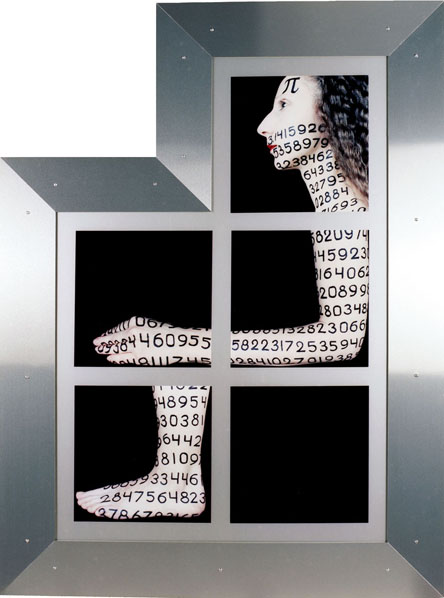
| Rimma Gerlovina and Valeriy Gerlovin, Pi © 1991/2007, C-prints in aluminum construction, 48 x 36" |
Suffice it to
say that we had a rooted interest not only towards words and their engaging
“in-word-ness” but also towards Pythagorean number symbolism. Valeriy used the
language of numbers as a tissue for his concepts that he literally engraved on
his metal reliefs. Naturally, some of them found their way in our photography,
as, for example, irrational mathematical constant Pi in the architectonic photocomposition under the same title. Pi is labeled as a transcendental number;
it can be carried out to an infinite number of decimal places without ever
arriving at a solution (its first 16 millions of digits have passed all the
tests of randomness used on them so far). According to the old recipe, the
proof of the Pi is in the eating.
Therefore, the supposed solution known as “squaring the circle” was one of the
most famous problems of antiquity (Pi
is the ratio of the circumference of a circle to its diameter). Yet, this number is above relation;
it is a constant because it holds for all circles, symbolizing a universal
synthesizing power.
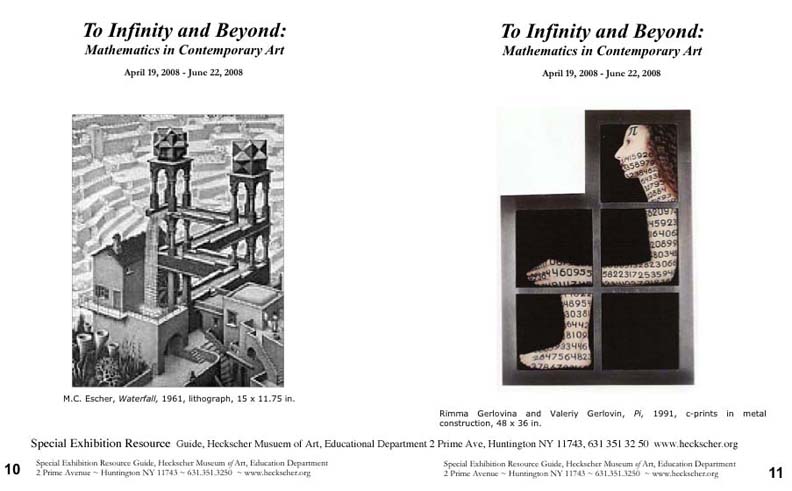
| Page from To Infinity and Beyond, Special Exhibition Resource Guide for Teachers, The Heckscher Museum of Art, Huntington NY, 2008 |
As it is
known, the infinite is not exhausted by the infinite manifestation, as the Sun
is not exhausted with its scattering raying. To further continue the celestial
analogy, the universe also can be viewed as a plasma
of endlessly recurring decimals. Naturally, that “plasma” has its reflection in
the human organism in a microcosmic sense. In that view, inscribing Pi on the human skin seems to extend its
transfinite message from strictly abstract to artistic parameters. The static
and “archeological” composition of that photograph has some similarity with the
Ancient Egyptian block statues. We “flattened” the block and visually reduced
the number of the body limbs, giving them an ephemeral look
of limbs with no body, and inscribed on them that infinite number.
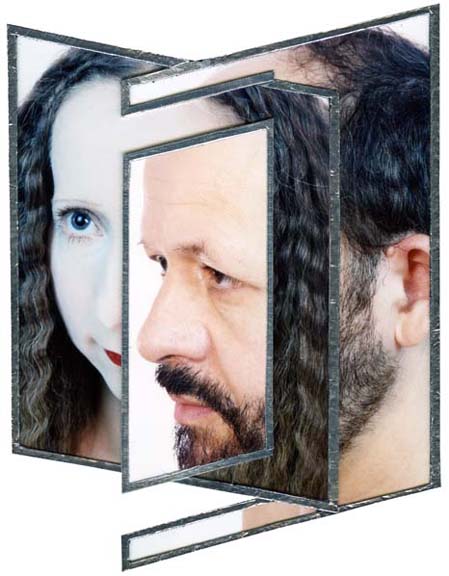
| Rimma Gerlovina and Valeriy Gerlovin, Double © 1996, C-prints in metal construction |
The three-stage artistic process
– idea, creation, result – reflects the three interlaced layers of
existence – intellectual, sensible, and physical – each of which
corresponds to a particular level of consciousness. That tripartite process was
replicated in the series of Photoreliefs:
first, the ideas were born and processed into the photo concepts, which, in
turn, “solidified” into sculptural objects. Thus, the inner world received its
projection into the outer world, so they were bridged through conceptual,
aesthetic, and “hands-on” methods.
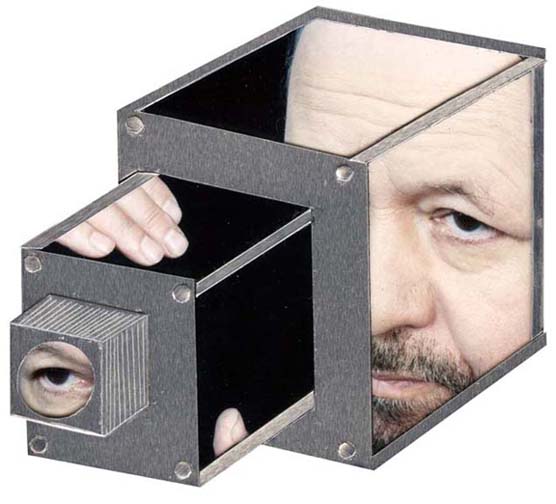
| Rimma Gerlovina and Valeriy Gerlovin, Cameraman © 2008, C-prints in metal construction |
As in the other cycles, Photoreliefs includes several
sub-series, such as Flat Solids, Unfolded Reliefs, Circles, Cutouts, and Superstrings.
While endowing the images with volume and depth, we also sought to adhere to
the rules of photography. The sequence of Flat
Solids is based on optical illusion. Although at first glance the works
look like three-dimensional bodies, they belong to the same “flatland” of
photography: their metal geometrical constructions are actually two-dimensional.
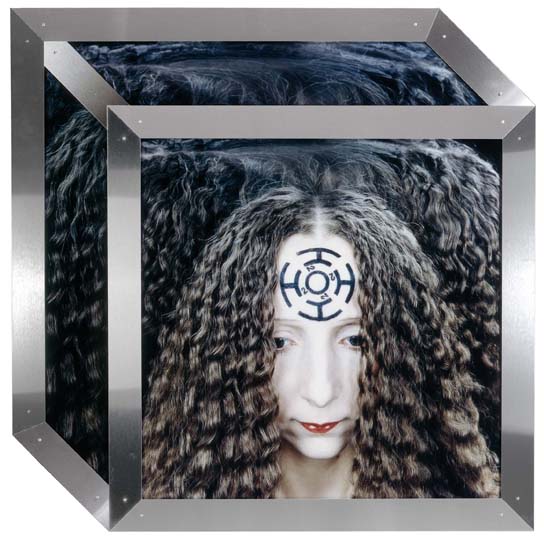
| Rimma Gerlovina and Valeriy Gerlovin, H2O © 1990/94, C-prints in stainless steel construction, 48 x 48” |
In the composition
H2O, featuring
pseudo-water in a pseudo-cube, the whirlpool of the “great deep” is created out
of hair, “incubated” in a similarly flat solid. The waterfall of hair increases
the illusion of the flat composition that appears as a cube. Here we tried to
unite a fluid indefinite form with the precise geometrical formation. The
visual images can give us a clue to the abstract thinking and subsequent analogies.
In that architectonic arrangement of “liquid," the perturbation of water seems
to redirect the whole system, which is only skin deep chaotic. Beneath it,
there is an intricate structure of regular periodic motion; in other words, the
universal matrix of the “great deep” in its receiving and creative state. Water
that always follows the path of least resistance is depicted live, staying in
perpetual circulation. Marked with the chemical seal of H2O, the alchemical
aqua permanens (enduring water) turns
the wheel of the moon calendar.
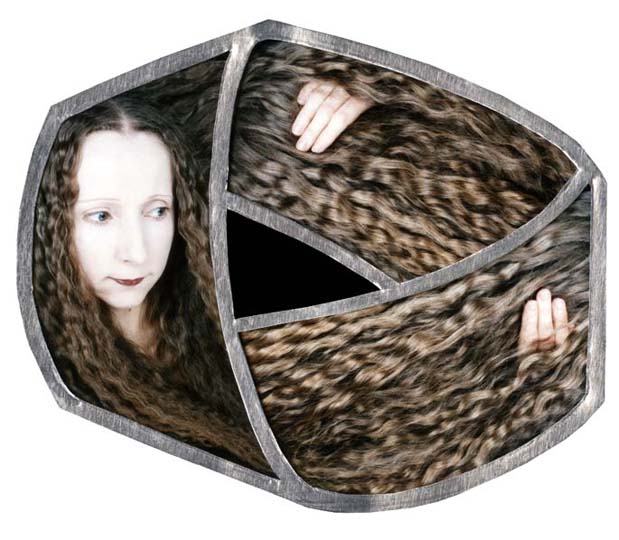
| Rimma Gerlovina and Valeriy Gerlovin, Möbius Strip © 1993, C-prints in metal construction |
Rotating with
tension and release, the enduring supply of aqua
vitae maintains the existence and preserves the ashes of dust from the
final diffusion. Following its Möbius Strip, it always returns to its
starting point having traversed every part of the strip without ever crossing
an edge.
Every living
creature plunging into a liquid phase of its formation passes through pre-birth
darkness and its chaos. Deepened into the baptistery of its mighty energy, not
only one stays alive but also is invigorated by turbulent waters of one’s own
“aquarium.”
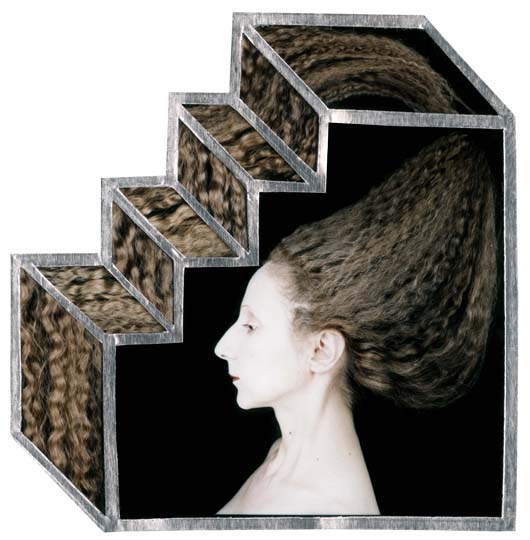
| Rimma Gerlovina and Valeriy Gerlovin, Waterfall © 1993, C-prints in metal construction |
The waterfall consists of drops that fall and disappear being renewed over
and over again. Such is life – the formation of an uninterrupted new
beginning of an uninterrupted inevitable end. In that context, the notions of “beginning”
and “end” are just a conceptualization. The cascades of waterfall show the
succession of moments that are passing by and immediately reconstruct
themselves, waving the metaphorical ripples of waters. On a psychological
level, people are involved in the perpetual process of sinking and emerging,
entering and leaving, and not without similarity to the waterfall. It seems
that each individual is preserved like a single drop of water; each helps to
swell the ocean.
Waterfall is one more visual metaphor for the structural chaos
of the irrepressible stream of life and the arrangement of that stuff which
likes to be uncontrollable. It often happens that symbols attract the things
that they symbolize, and vice versa; things evoke
their symbols. We seemed to experience it while visiting Niagara Falls not long
before we made this work. The shaky law of coincidences helped us to look more
precisely at the meaning of this “watery” subject and inspired us to put
another individual drop in its deep waters.
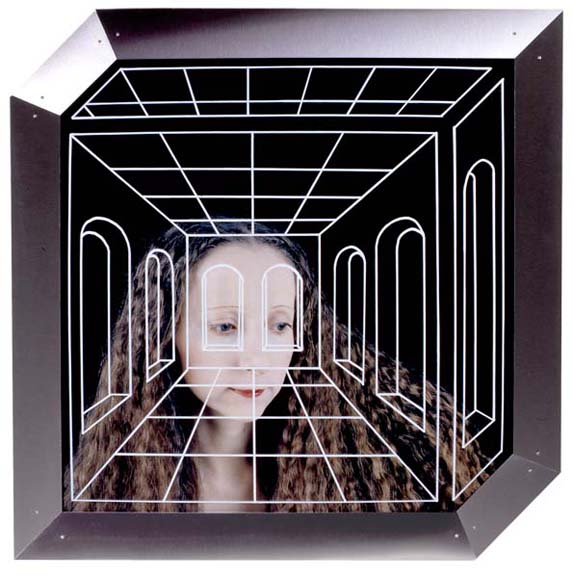
| Rimma Gerlovina and Valeriy Gerlovin, Perspective © 1992, C-print in stainless steel construction, 48 x 48” |
In Perspective, the architectural perspective drawing creates an
illusion of three-dimensionality. The face was photographed through the
Plexiglas with the drawing of the Quattrocento-like panorama, in which the
proportions between the real and the imagined, the face and the architectural
structure, became adjusted. Here, the impersonal was configured through the
personal and vice versa, creating something of an artistic convergence between
a man and his temple. As all old temples were conceived according to the canon
of the scale of man himself, our Perspective
followed the same rule. As always, man is the measure of all things in both his
own life and his environment, no matter what he preaches.
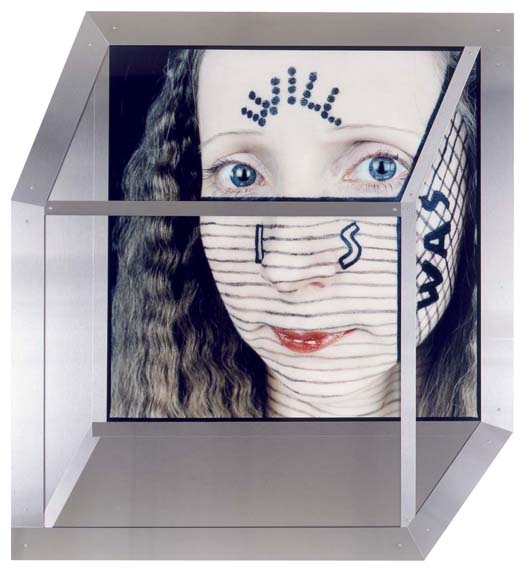
| Rimma Gerlovina and Valeriy Gerlovin, Was–Is–Will © 1992, C-print in stainless steel construction, 48 x 44” |
Like Friar Bacon's brazen head, I've spoken,
"Time is," "Time was," "Time's past."
Lord
Byron, Don Juan, i. 217
The
concept of time goes through all of our art in the manner of Ouroboros, the
tail-devouring snake, assuming different forms and substances: linear, spiral,
liquid, sandy, cubic, and, of course, anthropomorphic. The eternal relates to
the temporal physical life as time relates to a clock face – whether it
exists or not, it makes no difference for time. It reels itself off through
eternity. The direct grasp of eternal ideas is impossible when one is locked
within the laws of man’s normal space-time-continuum. For that reason, the
creative arts help us to fill this gap with imagination capable for time
traveling between the worlds (and the words.) More precisely, the Flat Solid
composition Was–Is–Will
depicts the cube “locked” within the space-time-continuum. That might be expressed in a variety of ways: verbally, visually, mathematically, or blended together in one unit.
√I = was I = am I2 = will
What is the
square root of “I” or the self? Perhaps, it belongs to the past. At the present
time, “I am that I am,” to borrow the biblical pronouncement in a humble way.
And what about the future? One raised to the second power? Will he or she be squared?
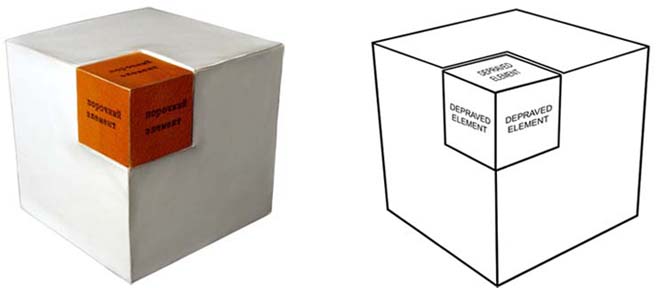
| Rimma Gerlovina,Depraved Element © 1974, cardboard, wood, paper, 3 ¼ x 3 ¼ x 3 ¼ |
With the removal of the small
orange cube titled “Depraved Element,” the perfect shape of the white cube, one
of the five absolute Platonic solids, is destroyed. Or if
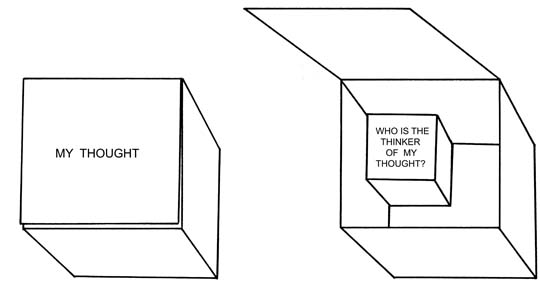
Many
geometric figures allude to important symbols that are only partly decodable.
Let us contemplate one of them. The cube can be presented in two forms: folded
and unfolded. While in folded form, a three-dimensional body symbolizes matter
and all that is earthly and bodily because it has stability and gravity. When it is unfolded into a
two-dimensional cross, its stability and gravity are “crucified,” to use a
conceptual metaphor of one domain to reason about the other.
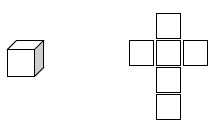
In many old doctrines with a legitimate perennial
paradigm, the cube is associated with the human body that contains a divine
spark, compressed within homo-cube. With its unfolding into a cross, that spark
is set free. Some things that are physically effective are not physical at all.
The same principle is reflected in the Kaaba, the Islamic
house of worship in Mecca. Built in a form of a hexahedron, it can serve as a
religious analog to the cube. In the Biblical version, each of the six sides of
the unfolded cube represent one day of creation; and the last one (the seventh)
which is not of that cube anymore, is its mystical crown. For this reason, many
pilgrims have mapped out their lives on that unfolded cube, whose fundamental
parameters are the same in different universal teachings.
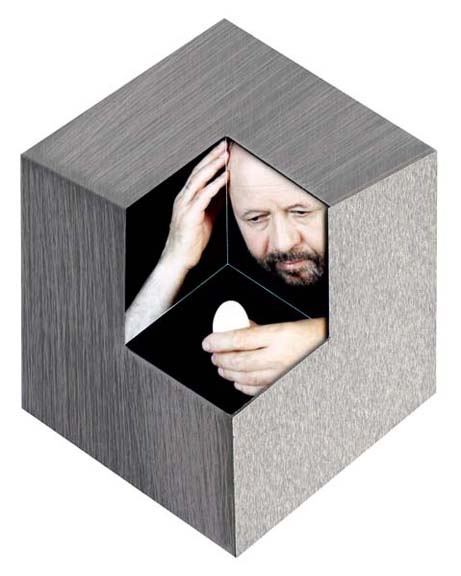
Rimma Gerlovina and Valeriy Gerlovin, Cube Insider © 2008, C-print in metal construction |
The metaphoric impact of these homo-cubes does not
inhibit a possibility of their polyvalent interpretation. Neither the brain is
the mind, nor the mind is the consciousness – but together, they
represent a crossword for their carrier. However, through the thinking process
and its “vibraining,” one comes closer to the physical expression of the
consciousness. Perhaps the Buddhist koan about two disputing chelae can illuminate
that idea from a different perspective. One of them says: “The weathercock is
moving;” the other opposes: “No, the wind is moving;” while upon hearing this,
their teacher concludes: ”Your minds are moving.”
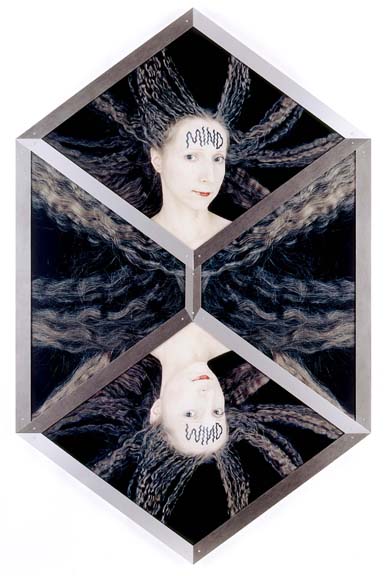
| Rimma Gerlovina and Valeriy Gerlovin, Mind-Wind © 1992, C-prints in aluminum construction with pencil drawing, 72 x 46” |
Our photographic twin-like composition Mind-Wind depicts the similar idea:
“mind” is written on one forehead, while on the other, it turns into “wind.”
Both photographs are printed from the same negative, but the second one is
flipped over. With what are we dealing here: “windless mind,” or “mindless
wind’? This is one more conundrum to contemplate.
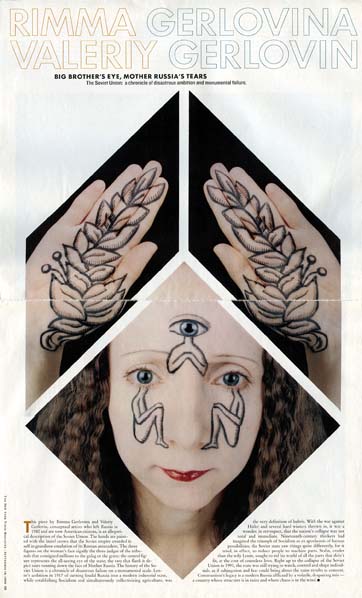
| Rimma Gerlovina and Valeriy Gerlovin, The Watching Eye © 1992, C-prints, reproduction in The New York Times Magazine, 9. 19. 1999 |
The Watching
Eye is also a Flat Solid
composition; it reflects both Russia’s religious
heritage and its social calamities. In
1999, exactly the day we landed in America 19 years ago, we received a proposal
from The New York Times Magazine to create
an image capturing Russian cultural and historical traditions for the Millennium Issue – a vision of the
past through time, reflected through the
creative imagination of different artists. Based on our comment, the title of
the editorial article has a political grasp – Big Brother’s Eye, Mother Russia’s Tears. The Soviet State gradually
intruded into the consciousness of the common man, who himself had become his
own watching eye in communist Russia. Resting on its temporary laurels, Soviet
socialism had developed into two simultaneously opposite directions: one towards
emancipation and the other towards the infringement of human rights. As Dostoyevsky predicted, “the most horrid crimes against freedom”
are committed “for the sake” of freedom. While true, there are more
comments on that thread.
In some
distant way, our work is a conceptual rendition of Andrei Rublev’s The Holy Trinity, the icon that was
counted among the most perfect and precious in Russia. This is not a place to
discuss the idea of the Trinity; it seems impossible to solve it, as it is
impossible to find the finite digit in the decimal expression of one third. Relation
of Unity and Trinity is endless:
1/3 = 0,3333333333333333…
On the “canvas” of the face, two figures are depicted as if they are
running down teas, while the third witness is just a watching eye. In Mother
Russia, it was always the face of the Motherland (in contrast to German Vaterland). Since each nationality has
its own picture of the feminine aspect, the Russian Madonna had distinctly
different psychological garments. According to Philokalia her “holiness and purity of soul is received through
fear of God.”1 Here we see an obvious stress on penances, hardships
of life, and the necessity of endurance, which is typical of Russian
iconography. It seems that the Russian character is made of a queer mixture of strength
and weakness, perseverance and vulnerability. Red-blooded fervor is often
afflicted with inertia. Something in this national soul is very delicate and psychic,
though not very healthy. Its intellectual passion is equal to the passionate
intellect; historically its great moral resistance has been imbued with the preaching
of suffering and hope for spiritual support.
In terms of the politics at the end of the millennium, the brutal
communist State has ground itself into dust, but that is a subject matter for
sociology and politics of which one can talk continually in a sinister way. To
get out of the domineering power of group thinking and the closed curve of the socium that holds many artists meddling
in hot social issues, one needs to acquire a more radical understanding than
the harsh criticism of society, which is, in fact, its immanent part. Let’s
make a generalization at that point. On a higher level, people are divided not
by nationality, but by consciousness. Only those who can be characterized by a
less developed consciousness are divided by nationalities, not being capable of
transgressing its boundary. Wise men geographically poles apart and sages of
different faiths immediately understand each other.
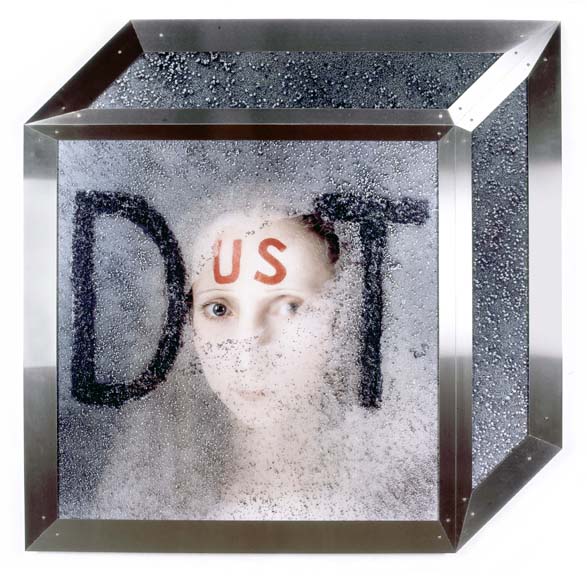
| Rimma Gerlovina and Valeriy Gerlovin, Dust © 1990-91, C-prints in metal construction, 48 x 48" |
In the fictitious cube Dust, “us” is written in red letters on
the forehead, acting as a catalyst on that “polymerous” concept of death. The
dust per se is a symbol of our mortal
atmosphere, and the prophecy on that account in Genesis 2:7 is not very
promising. Yet, however grave the appearance of impartiality worn by the
eternal, it seems to “meet its end” in human consciousness. Since between birth
and death there is life, it is reasonable to expect that between death and birth
there is also life, but in a state of immersion, say, in such dust that our own
faces are hidden from us. The vitality of life, with its continuous flux of
expansion and compression of energy, cannot be simply left behind unless
metamorphosed into another form, even one completely undetectable. Dust’s context increases the illusion of
volume, bringing it into the square package of diffused particles, a
theoretically suspicious combination of shape and shapelessness. Therefore, at
this point it is better to condense the discussion of death and earthly dust
into a couple of simple thoughts: death is a regression into hiddenness, dust
is a cosmic material, and cosmos in Greek means “order.”
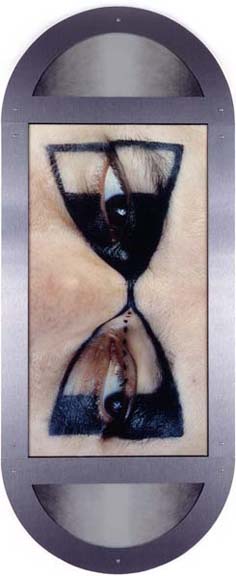
| Rimma Gerlovina and Valeriy Gerlovin, Hourglass © 1989, C-print in metal construction, 43½ x 17¾" |
Watching a
flow between the bulbs of a sandglass, one can perceive intuitively how the
pivotal “now” operates between “before” and “after,” between our desires for
the future and our memories of the past. That is a zero point through which the
plus and the minus are processed. All happens as a single act. Even if it were
so, this single act is put on a loop, kind of a revolving hourglass. In a
horizontal position, the very shape of that device outlines the sign of
infinity. Time flows through our “eyeglasses” always too
![]()
Following the above-mentioned
precepts, we wrote a polylogue about death, while developing it upon the speculative background that has provoked the
intensive thinking of many minds.
UNLI’MITED
(A play for polyphonic voices for dramatic personae; no limit to their
numbers.)
Hamlet. (Moody) To be or not to be: that is the question.
Whitman. (Confidently)
Has anyone supposed it lucky to be born? I hasten to inform him or her,
it is just as lucky to die and I know it.
Socrates. (Aside) The business of a philosopher is a continuous
exercise in dying.
Eckhart. I was born to and for eternity and because of my
eternal birth, I shall never die.
Blake. (Pressing) I cannot think of death as more than the
going out of one room into another.
A voice from Amphitheater. (Mocking) A mosquito that dies daily is going
through the spinning door between these rooms incessantly, is it not?”
Mosquito. (Full of vital fluids) Bloody fools! I am what I
am!
St. Paul. (In a conciliatory way) I die daily.
Kierkegaard. (Sick unto death) For when I am dead, I am immortal.
Sri Aurobindo. (Thoughtfully) When I live or die, I am always.
Heidegger. (Clutching his garters with self-confidence) Why is
being altogether being and not nothing?
The Buddha. (Refuses to speak on the ground that affirmation or
negation equally raises misunderstanding.)
(The voices continue to grow and multiply interfering
with each other. Abrupt sentences in different languages are heard from the distance)
…raison d'źtre…
Who will deliver me from the body of this death?…
Mors certa, hora incerta…
Does not an infant die to become a child?…
E=mc2 …
La vita es sueĖo…
Death is merely a translation back to the soul’s
element…
Ding an Sich…
отдать
концы в
бесконечность…
memento…
more…
No end
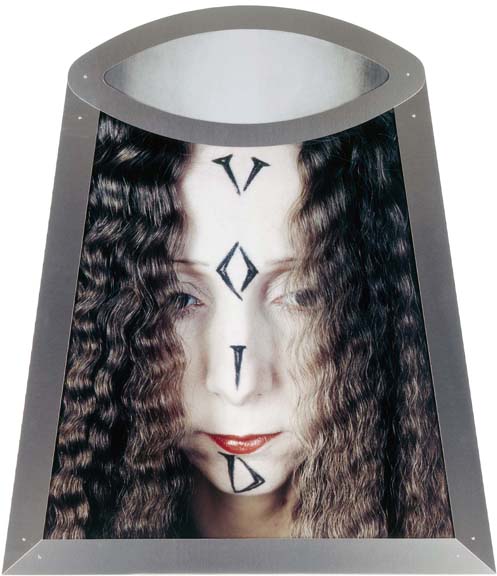
| Rimma Gerlovina and Valeriy Gerlovin,Void © 1989/94, C-print in stainless steel
con-struction, aluminum, pencil drawing, 48 x 41 ¾”
|
In the flat solid Void, the “voidness” of that very word
seems to fill all of its psychological space. Does non-existence exist? The
emptiness holds the maximum potential in its vacuum. It is a zero-point field
that contains the least irremovable energy. Perhaps, the concept of the
Buddhist sunyata presupposes the same emptiness in its potential wholeness. To
put it another way, exhausting all views, sunyata is not itself another view.
Emptiness and its mathematical expression, zero, might be observed in a variety
of ways, even via its antithesis, abiding by the proposition of the meeting of
extremes. For example, zero, which in our works often assumes the form of an
egg, conveys its potential in an organic way.
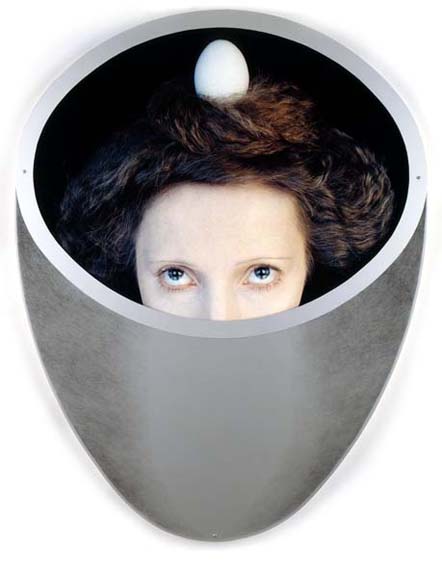
| Rimma Gerlovina and Valeriy Gerlovin, Egg © 1992/94, C-print in aluminum construction with pencil drawing, 42 x 32” |
The flat half-spheroid Egg contains a nest of hair within the
egg as the potential for yet another egg and so forth ad infinitum. The metal relief’s illusion of volume was achieved by
its cut-out form, along with subtle cross-hatching in pencil. The embryo develops within the egg when the reproductive
cell is fertilized. The egg seems to be a chicken's way of making another
chicken. It's different with people, some of them are able getting real eggs
from illusory chickens. Analytically, the egg is an organic (or creative) end
that hatches its own beginning.
Following the same rules in
the development of the series Photoreliefs, we can move from Flat Solids to the next Unfolding
Series that continues 3D illusion giving rise to a corresponding
deceptive “algebra” of the imagination.